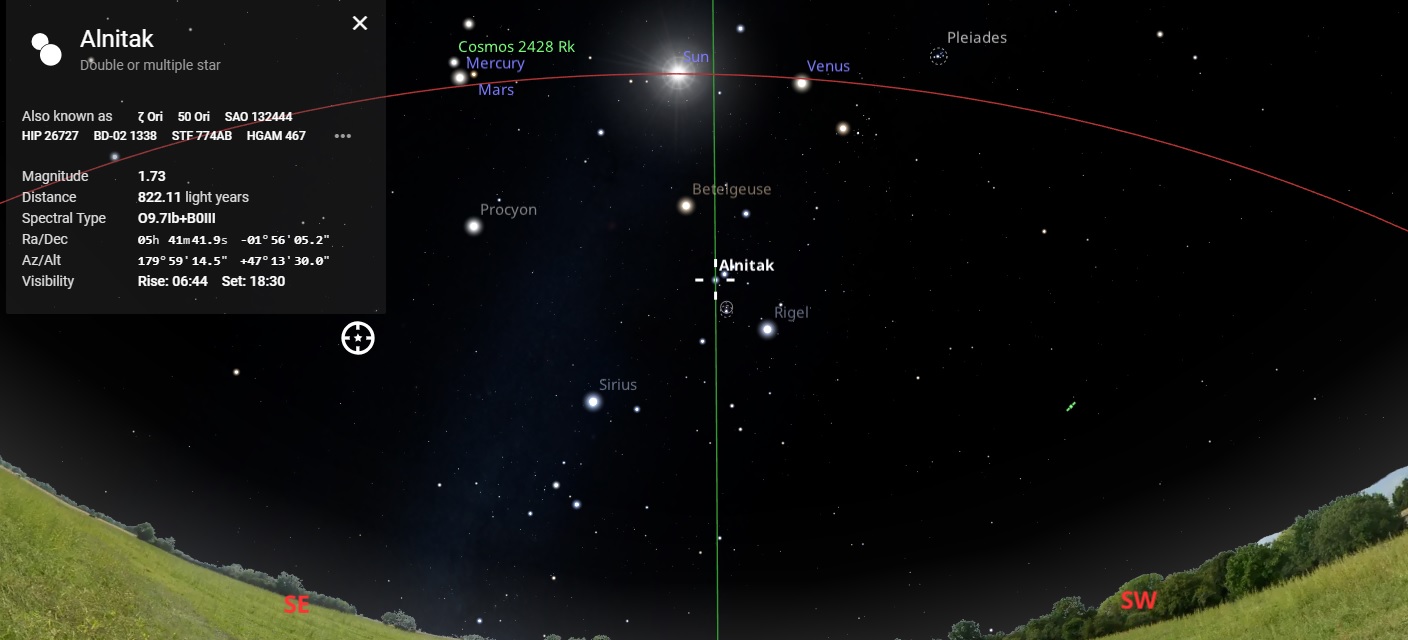
This view is at mid-day today, as the sun crosses the meridian (the green line) and is as it would appear if we could eliminate the Earth’s atmosphere and observe the sun, moon, planets and stars set against a jet-black sky. Note that the angular separation between the sun’s position on the ecliptic (the red line and the imaginary path all solar-system objects appear to travel on) and the star Alnitak, the first star in the Belt of Orion. The position of that star is very close to the Celestial Equator, the projection of the Earth’s Equator onto the sky. The separation of these two points, the sun’s position on the ecliptic at local noon and the Celestial Equator at the Summer Solstice is exactly equal to our planet’s angular tilt from the vertical of 23.5º.
As the last vestiges of the winter sky are low in the west at twilight, we look forward to the late spring and early summer sky.
With Lyra the celestial harp ascending the northeastern sky towards midnight along with Cygnus and the rich summer Milky Way following close behind, we’re certain that spring is here and that summer will soon follow. Many would consider this their favorite time of year, a time that harkens back to younger days, to a time when you could see magnitude 5.5 stars (the faintest stars visible to the eye are magnitude 6) and a breathtaking view of the Milky Way from many suburbs. With the fresh spring air, the sweet smell of Lilacs and Honey Suckle wafting about and the temperature and humidity still moderate, it’s truly a pleasure to be out under the stars.
The Summer Solstice Occurs today, June 21st, 15:54 UTC (11:54 EDT)

View to the south tonight, 21 June, this year’s Summer Solstice. Note the waning gibbous moon, located at the boundary of Capricorn and Aquarius to the east. Mighty Jupiter flanks Antares and Serene Saturn hovers to the east in Sagittarius set against the Galactic Center, the heart of the Milky Way.
Although already past on the 17th, the full moon for this month, June, is historically known as the Strawberry Moon, the time of year when wild strawberries start to ripen during early summer. The June full moon is also known by other names such as Rose Moon, Hot Moon, and the Mead Moon. Placed low in the west after sunset, you’ll see brilliant Mercury flanked by ruddy-red Mars just above the western horizon. Speaking of the moon, over the next week, the waning gibbous moon will appear to move through Capricorn and Aquarius, and will be shrinking towards 3rd quarter on the 25th and new moon on July 2. In our view to the south, mighty Jupiter flanks Antares and Serene Saturn hovers to the east in Sagittarius set against the Galactic Center, the heart of the Milky Way.
The Summer Solstice is the astronomical beginning of Summer and the day locations in the northern hemisphere receive the greatest amount of energy from the sun at its highest point in the sky at mid-day; this year, that occurs at 15:54 PM, UTC (11:54 AM, EDT). This angle above the southern horizon, known as the “Angle of Insolation”, determines how much energy from the sun a given location receives. The Summer Solstice is also the one day of the year with the greatest extent of daylight or the longest day and, correspondingly, the shortest night.
It is interesting to point out that the Summer Solstice marks the point when the energy received from the sun is already at its maximum and therefore, to suggest that it is “the beginning of Summer” is somewhat misleading. Due to climactic factors and buffering by the earth’s atmosphere, we don’t feel the full effects of this maximum energy received for at least a month into July and August.
In a rare spectacular display set in Sagittarius, Mighty Jupiter, our solar system’s largest planet and Saturn, the ringed beauty will be visible to the south, set against the milky way and the Galactic Center! A pair of binoculars or a wide-field telescope will give breathtaking views of this vista.

In a rare and spectacular display set in Sagittarius, Mighty Jupiter and the Ringed Serenity of Saturn are visible set against the heart of our galaxy, The Milky Way! A pair of binoculars or a wide-field telescope will give breathtaking views of this vista.
Author’s Note
This article’s Feature image is a digital rendering with Stellarium of this year’s Summer Solstice and where the sun will be in relation to the various constellations at that time. This view is at mid-day, as the sun crosses the meridian (the green line) and is as it would appear if we could eliminate the Earth’s atmosphere and see the sun, moon, planets and stars set against a jet-black sky. Note that the angular separation between the sun’s position on the ecliptic (the red line and the imaginary path all solar-system objects appear to travel on) and the celestial equator. This separation between the sun’s position on the ecliptic at the Summer Solstice and the Celestial Equator is exactly equal to our planet’s angular tilt from the vertical of 23.5º.

